Day 3: Fairport to Lyons
Friday, August 6, 1999
We had breakfast at Riki’s in Lockport at 6:30 a.m., then were on our
way around 7:30 a.m.
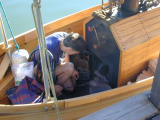 |
Al puts wood into the firebox. | |
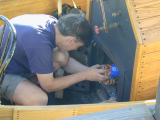 |
A little lighter fluid helps start the fire. |
|
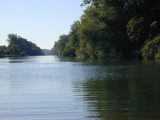 |
On the canal. | |
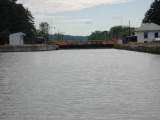 |
Lock 29. |
|
We locked through Locks 30 (lift 16.4 feet) at Macedon and 29 (lift 16.0
feet) at Palmyra. No, I didn’t forget to mention Lock 31. There
isn’t one.
The earlier Erie Canals followed approximately this same path. Marsh
grasses on one side or the other of the canal would hint at former paths.
We met our friends Dave and Barbara in their beautiful Liberty tugboat
Charity just below Lock 29 at Palmyra, birthplace of the Mormon religion.
They live in their boat at Miller’s Marine in Lyons between Locks 28A and
27.
We walked through the Palmyra-Macedon Aqueduct Park. Dave, who
used to be a superintendent in a western section of the Erie Canal, knew
much about the history of the canals. He pointed out an old boat
that used to go around and light the kerosene lamps on the buoys.
It had two tanks, one for kerosene and one for diesel. In 1926, there were
2600 lighted navigational aids.
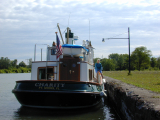 |
Barbara and Charity. | |
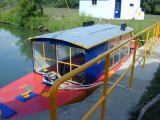 |
Buoy boat to light lamps in navigational aids with kerosene. |
|
 |
Remnants of aqueduct and tow path over Ganargua Creek.The lower part used to contain a trough of timbers carrying the canal. The arches supported the towpath. | |
 |
Heron on sill of lock. |
|
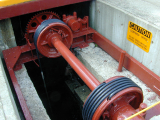 |
Lock valve. | |
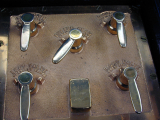 |
Lock controls. |
|
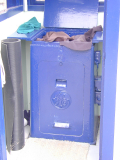 |
GE symbol. | |
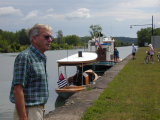 |
Dave. Aurora Borealis and Charity. Barbara is in the background near Charity. |
|
 |
Al. | |
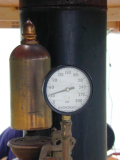 |
Whistle, pressure gauge, and stack. |
|
Although there is no Lock 31, there are two Locks 28: 28B (lift 12.0 feet)
at Newark and 28A (lift 19.5 feet) at Lyons through which we passed.
Dave and Barbara escorted us down to their dock at Miller’s Marine,
sometimes going ahead of us and sometimes behind. In the Wide Waters
section of the canal, which was like a small lake with cottages on it,
the wind came up. We had heavy rain at times.
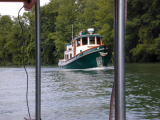 |
Charity. | |
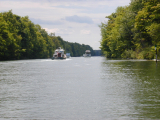 |
Heavy traffic on the Erie Canal. |
|
Dave showed us some generating equipment at one of the locks. He
told us that the “E” in the GE logo comes from the script “E” that Thomas
Edison used in initialing things he had read. The “G” was then made
to match it. In Schenectady, the opening of the Erie Canal and the
growth of the railroads had led Edison to establish his Edison Machine
Works during the late 1800’s. It merged with other companies
to become the General Electric Company.
Much of the machinery in use on the canal dates back to 1918.
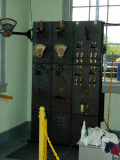 |
Powerhouse. | |
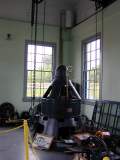 |
Powerhouse generator. |
|
We saw the remnants of an aqueduct that used to cross Ganargua Creek.
At an old lock from the Enlarged Erie Canal, we observed grooves where
tow ropes had worn down the stone.
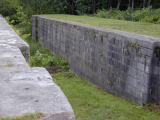 |
Lock from Enlarged Erie Canal. | |
 |
Grooves in the stone of the lock, worn by countless towropes. |
|
After a dinner at Burger King, Dave and Barbara drove us on a fascinating
tour of the Lyons area. (Alas! I didn’t take my camera.)
We peeked at a steam-powered dredge at the dry dock at Lock 28A.
In Lyons, we saw an old jail with bars on its windows. It is now
a museum. Unusual hills in the region are drumlims, created during
a glacial era. Gravel is normally found on their east sides.
What interested me greatly was seeing the original Clinton’s Ditch,
the Enlarged Erie Canal, and the present day Barge Canal, sometimes all
in separate places. Clinton’s Ditch has mostly disappeared, so it
was exciting to drive along a good long stretch of it. Completed
in 1825, it truly appeared to be hardly more than a ditch. The prism
(cross-section) was forty feet at the top and twenty-eight feet at the
bottom by four feet deep. It was built along contour lines and meandered
all over the place. It originally had 83 locks, 18 aqueducts, and
rose 568 feet from the Hudson River to Lake Erie.
It was truly an engineering marvel at the time that it was constructed.
There were no professional engineers working on the project. People
learned through “on-the-job” experience as they went along. This
experience led to the establishment of Rensselaer Polytechnic Institute,
Rochester Institute of Technology, and the Civil Engineering Department
of Union College. With a few exceptions where the newly-invented
black powder of DuPont’s was used to blast through the hard rock of the
Niagara escarpment at Lockport, men and horses alone built the canal.
Clinton’s Ditch opened a trade route west of the Appalachians.
At that time, the Allegheny Mountains were the western frontier.
Settlers migrated westward with the completion of the canal.
When the Enlarged Canal was built, it was 50 miles (?) shorter. The
prism was eighty and sixty feet by four and a half feet deep.
We stopped to see a double lock from the Enlarged Erie Canal. The
locks were side by side. One was longer than the other (and
built later) so that a double boat could go through.
Between 1905 and 1918, the New York State Barge Canal was constructed
so that the canal could transport large barges. Much of the original
man-made channel was eliminated. Instead, rivers were “canalized”:
the Clyde, Oneida, Seneca, Oswego, Mohawk. Also, the Barge Canal
went through Oneida Lake.
In 1959, the St. Lawrence Seaway was opened. Today, the barges
have nearly disappeared and the traffic consists almost entirely of pleasure
boats.
 |
Dave helping Al load wood. |
Ben, who was running the marina for the day, offered to let us sleep
in his boat. It was threatening to rain, so we took him up on his
offer.
Number of locks: 4
Approximate distance for day: 25 miles
Next day Previous
day Steamboat trip index


